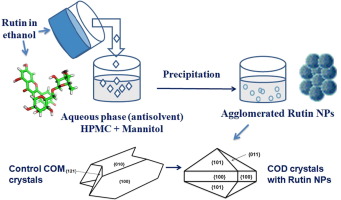当前位置:
X-MOL 学术
›
J. Cryst. Growth
›
论文详情
Our official English website, www.x-mol.net, welcomes your
feedback! (Note: you will need to create a separate account there.)
A facile preparation of rutin nanoparticles and its effects on controlled growth and morphology of calcium oxalate crystals
Journal of Crystal Growth ( IF 1.7 ) Pub Date : 2020-06-01 , DOI: 10.1016/j.jcrysgro.2020.125635 Sarmistha Saha , Abhijit Mishra
Journal of Crystal Growth ( IF 1.7 ) Pub Date : 2020-06-01 , DOI: 10.1016/j.jcrysgro.2020.125635 Sarmistha Saha , Abhijit Mishra

|
Abstract Switching of the growth-mode of calcium-containing crystals are of great research interest in materials science for the inhibition of pathological biomineralization. Rutin, a flavonol glycoside, was reported to have many pharmacological activities. However, the efficiency of rutin for practical therapeutic applications is still a challenge due to its low aqueous solubility and limited bioavailability. Herein, we report a facile method for preparation and characterization of rutin nanoparticles of ~200 nm in size and zeta potential of −22.70 ± 2.51 mV, based on anti-solvent co-precipitation using the synergistic effect of surfactants. Morphological and structural characterization of the nanoparticles was carried out with scanning electron microscopy (SEM), transmission electron microscopy (TEM), dynamic light scattering (DLS), Fourier transform infrared spectroscopy (FTIR), differential scanning calorimetry (DSC), thermal gravimetric analysis (TGA), and powder X-ray diffraction (XRD) patterns. These results showed that rutin nanoparticles had a smaller particle size than raw rutin, and changed into an amorphous structure from the crystal structure of raw rutin. In vitro release profiles showed a sustained release rate of hydrophilic rutin nanoparticles corresponding to 83.5 ± 8.4% for a time period of 8 days. Furthermore, the influence of the rutin nanoparticles on the tuning of the growth and morphology of calcium oxalate (CaC2O4) crystals have been assessed using SEM, XRD patterns, TGA analysis and adsorption isotherms. The experimental results showed that the rutin nanoparticles could induce the formation of oval and octahedral calcium oxalate dihydrate (COD) crystals in a concentration-dependent manner. It is believed that the hydrogen bonding between the phenolic groups in rutin with carboxylate ions in crystals contributes to their increased adsorption and directing calcium oxalate monohydrate to dihydrate forms. These results indicated the potential application of rutin nanoparticles for in vivo lithiatic studies as well as for other pharmacological properties.
中文翻译:

芦丁纳米颗粒的简便制备及其对草酸钙晶体可控生长和形态的影响
摘要 改变含钙晶体的生长模式在材料科学中对抑制病理性生物矿化具有重要的研究意义。据报道,芦丁是一种黄酮醇糖苷,具有多种药理活性。然而,芦丁在实际治疗应用中的有效性仍然是一个挑战,因为它的水溶性低且生物利用度有限。在此,我们报告了一种基于使用表面活性剂的协同作用的抗溶剂共沉淀,制备和表征尺寸约为 200 nm 和 zeta 电位为 -22.70 ± 2.51 mV 的芦丁纳米颗粒的简便方法。通过扫描电子显微镜 (SEM)、透射电子显微镜 (TEM)、动态光散射 (DLS)、傅里叶变换红外光谱 (FTIR)、差示扫描量热法 (DSC)、热重分析 (TGA) 和粉末 X 射线衍射 (XRD) 图。这些结果表明,芦丁纳米颗粒比原料芦丁具有更小的粒径,并且由原料芦丁的晶体结构转变为无定形结构。体外释放曲线显示亲水性芦丁纳米颗粒的持续释放率对应于 83.5 ± 8.4%,持续 8 天。此外,芦丁纳米颗粒对草酸钙 (CaC2O4) 晶体的生长和形态调节的影响已经使用 SEM、XRD 图案、TGA 分析和吸附等温线进行了评估。实验结果表明,芦丁纳米颗粒可以以浓度依赖性方式诱导椭圆形和八面体草酸钙二水合物(COD)晶体的形成。据信,芦丁中的酚基与晶体中的羧酸根离子之间的氢键有助于它们的吸附增加并将草酸钙一水合物导向二水合物形式。这些结果表明芦丁纳米颗粒在体内锂研究以及其他药理特性方面的潜在应用。
更新日期:2020-06-01
中文翻译:

芦丁纳米颗粒的简便制备及其对草酸钙晶体可控生长和形态的影响
摘要 改变含钙晶体的生长模式在材料科学中对抑制病理性生物矿化具有重要的研究意义。据报道,芦丁是一种黄酮醇糖苷,具有多种药理活性。然而,芦丁在实际治疗应用中的有效性仍然是一个挑战,因为它的水溶性低且生物利用度有限。在此,我们报告了一种基于使用表面活性剂的协同作用的抗溶剂共沉淀,制备和表征尺寸约为 200 nm 和 zeta 电位为 -22.70 ± 2.51 mV 的芦丁纳米颗粒的简便方法。通过扫描电子显微镜 (SEM)、透射电子显微镜 (TEM)、动态光散射 (DLS)、傅里叶变换红外光谱 (FTIR)、差示扫描量热法 (DSC)、热重分析 (TGA) 和粉末 X 射线衍射 (XRD) 图。这些结果表明,芦丁纳米颗粒比原料芦丁具有更小的粒径,并且由原料芦丁的晶体结构转变为无定形结构。体外释放曲线显示亲水性芦丁纳米颗粒的持续释放率对应于 83.5 ± 8.4%,持续 8 天。此外,芦丁纳米颗粒对草酸钙 (CaC2O4) 晶体的生长和形态调节的影响已经使用 SEM、XRD 图案、TGA 分析和吸附等温线进行了评估。实验结果表明,芦丁纳米颗粒可以以浓度依赖性方式诱导椭圆形和八面体草酸钙二水合物(COD)晶体的形成。据信,芦丁中的酚基与晶体中的羧酸根离子之间的氢键有助于它们的吸附增加并将草酸钙一水合物导向二水合物形式。这些结果表明芦丁纳米颗粒在体内锂研究以及其他药理特性方面的潜在应用。









































 京公网安备 11010802027423号
京公网安备 11010802027423号